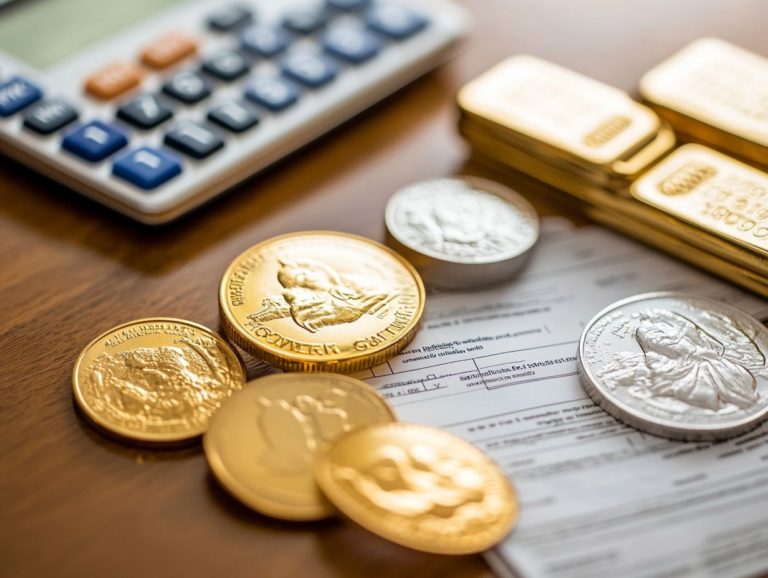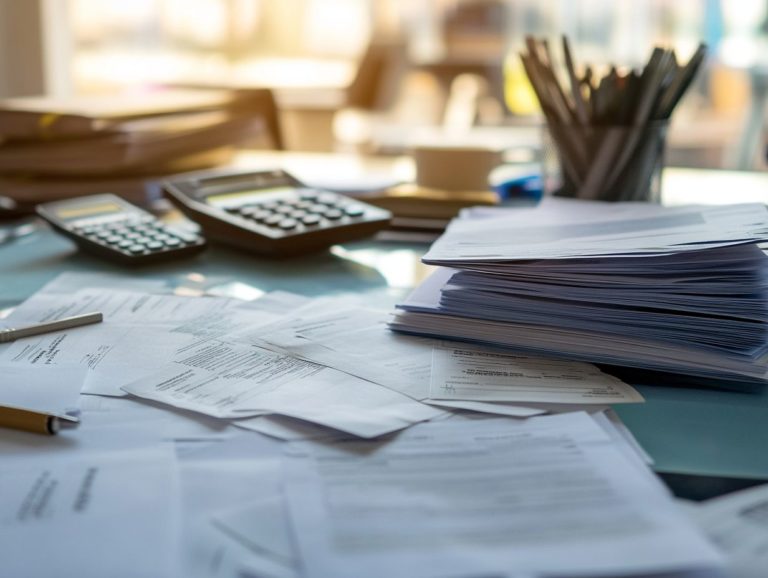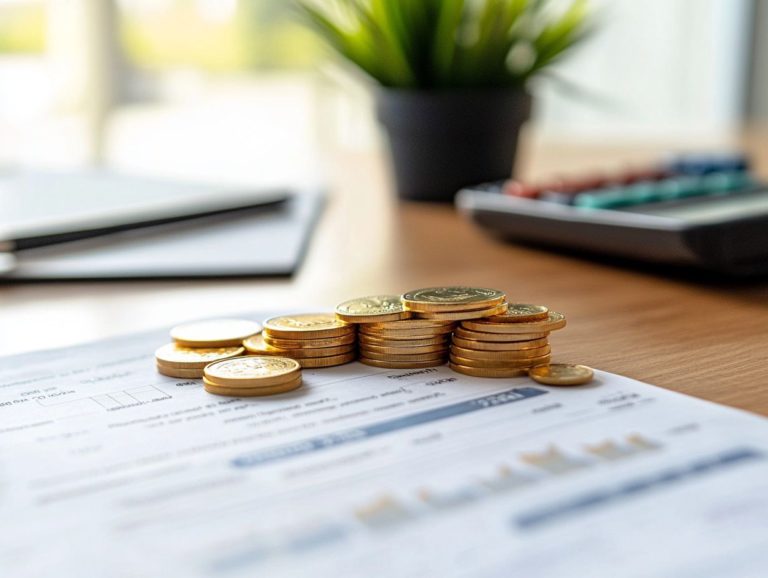Understanding Your Tax Obligations for Precious Metals
Navigating the world of precious metals can be exciting, but it also comes with important tax responsibilities.
Whether you’re an experienced investor or new to this field, understanding the taxes like income tax, capital gains tax, and sales tax related to your precious metals is key.
This article offers a clear overview of these taxes, outlines what you need to report, and shares effective strategies to lower your tax burden. We ll also point out common mistakes to avoid, ensuring your investment journey is both rewarding and compliant.
Contents
- Key Takeaways:
- What are Precious Metals?
- Types of Taxes on Precious Metals
- Reporting Requirements for Precious Metals
- Strategies for Minimizing Taxes on Precious Metals
- Common Tax Mistakes to Avoid
- Frequently Asked Questions
- What are the tax obligations for buying and selling precious metals?
- Do I have to pay sales tax when buying precious metals?
- Are there any tax exemptions for precious metals?
- What happens if I sell my precious metals at a loss?
- What is the tax rate for capital gains on precious metals?
- What documents do I need to keep for tax purposes when dealing with precious metals?
Key Takeaways:

- Know the different taxes on your precious metals: income tax, capital gains tax, and sales tax.
- Stay on top of reporting requirements to avoid unnecessary penalties.
- Use tax-saving strategies to help lower your tax bill.
What are Precious Metals?
Precious metals Gold, Silver, Platinum, and Palladium are valuable resources known for their intrinsic value, rarity, and unique properties. Their allure makes them popular among both investors and collectors.
These metals serve multiple purposes: they act as investment assets, essential industrial components, and exquisite materials for jewelry, solidifying their importance in the global economy.
For example, investment vehicles like the Sprott Physical Gold and Silver Trust offer a straightforward way for investors to engage with these commodities without the complexities of physical ownership.
Types of Taxes on Precious Metals
When trading and investing in precious metals, various taxes come into play, including income tax, capital gains tax, and sales tax. These can significantly influence your profits and financial planning strategies. It s crucial for anyone involved in precious metal investments to fully understand these tax implications.
Different states in the U.S. have their own regulations and rates concerning these taxes, which can ultimately impact the overall market value and your returns. Understanding these nuances enables you to make informed decisions and optimize your investment outcomes.
Income Tax
Income tax on precious metals typically arises when you realize profits from selling these assets, affecting your overall taxable income. You ll want to understand how gains from transactions involving precious metals including those within Individual Retirement Accounts (IRAs) are reported and taxed according to IRS regulations.
When you engage in buying or selling precious metals, understanding what constitutes a taxable event is crucial. This includes selling bullion, coins, or numismatic items for a profit. Generally, these transactions fall under capital gains, and the IRS requires you to report them accordingly.
There may be specific exemptions, such as losses that can offset gains and potentially reduce your total tax liabilities.
You might also consider strategies like using long-term capital gains rates or tax-deferred accounts to manage your taxable income effectively. By adhering to IRS guidelines, you can ensure compliance and minimize the risk of unexpected tax consequences.
Capital Gains Tax
Capital gains tax is a crucial factor for you to consider as an investor in precious metals. It is levied on the profits you make from selling collectibles. It often comes with a higher tax rate compared to other assets. The IRS classifies precious metals as collectibles, which means you could face a capital gains tax rate of up to 28%. This starkly contrasts with the more favorable 15% or 20% rates applicable to other investments, making it essential for you to strategize effectively.
Understanding these tax implications is vital, especially as you navigate the distinctions between long-term and short-term capital gains. If you hold your precious metals for over a year, you’ll benefit from a lower tax rate. However, you’ll still encounter that unique collectible tax of 28%. On the other hand, if you sell within a year, be prepared for higher short-term capital gains rates that align with ordinary income tax brackets.
To optimize your investments and potentially reduce your tax burdens, consider exploring strategies like tax-loss harvesting, a method where you sell investments at a loss to offset taxes on gains, or leveraging tax-advantaged accounts. Keep in mind the specific nature of precious metals.
Sales Tax

Sales tax on precious metals can vary greatly by state. Some areas may offer exemptions for investment-grade metals, while others impose taxes that could eat into your profitability.
It is essential to grasp these state-specific regulations to ensure compliance and avoid any unwelcome tax surprises when understanding the tax obligations of precious metals.
Take Texas and Wyoming for example; in these states, precious metals like gold and silver bullion are exempt from sales tax, making them highly appealing for those wishing to invest without incurring extra costs. On the flip side, states like New Jersey and Illinois impose sales tax on precious metal transactions, which can considerably impact your overall investment returns.
These variations underscore the necessity of being well-informed about local tax laws, as they can influence not only your purchase costs but also your potential profits upon resale. It is wise to conduct thorough research or consult with professionals to effectively navigate these diverse regulations.
Reporting Requirements for Precious Metals
Understanding the reporting requirements for precious metals investments is essential for maintaining compliance with IRS regulations, particularly when you realize gains or engage in specific transactions.
You must meticulously document your activities, including filing the necessary forms like Form 8621 for foreign investment structures that may require special reporting. This diligence is key to accurately reporting your income and sidestepping any potential penalties.
Forms and Deadlines
Understanding the various forms and deadlines related to reporting precious metals transactions is crucial for you as an investor. This ensures you stay on the right side of tax compliance and avoid those pesky IRS penalties. Key forms, like Form 8621, should be filed promptly usually alongside your annual income tax returns to accurately convey gains and losses from your precious metals investments.
Besides Form 8621, it is important for you to keep an eye on other vital documents, such as Form 1099-B, which details the sale of these assets. However, it s not just about filling out forms; organizing your documentation throughout the year can significantly lighten your tax season load. By maintaining meticulous records of purchase dates, costs, and sale amounts, you ensure that everything is readily available when tax time rolls around.
Filing on time is crucial to avoid audits and penalties. Don t delay stay ahead of deadlines!
Strategies for Minimizing Taxes on Precious Metals
Utilizing effective strategies to minimize taxes on precious metals can greatly elevate your investment returns, enabling you to enjoy increased profits while lowering your liabilities.
By taking advantage of tax-advantaged accounts and employing tax-loss harvesting techniques, you can navigate the intricate tax landscape with greater ease, ensuring the protection of your assets. By taking these steps, you can maximize your returns and keep your investments secure.
Tax-Advantaged Accounts
Tax-advantaged accounts, especially Individual Retirement Accounts (IRAs), present you with a remarkable opportunity to easily include precious metals in your investment strategy while deferring taxes on both income and capital gains. By leveraging ways allowed by the IRS, you can seamlessly blend these tangible assets into your retirement portfolio, effectively shielding your wealth from immediate tax liabilities.
This approach not only allows you to potentially reap the rewards of appreciating precious metals, but it also grants you the peace of mind that comes with tax deferral until you decide to make withdrawals in retirement. Certain types of IRAs, like a Self-Directed IRA, afford you the flexibility to choose specific IRS-accredited metals, including gold, silver, platinum, and palladium. Keep in mind the stringent regulations governing these accounts, as well as the necessity of storing your metals in compliant depositories.
By fully grasping both the advantages and limitations of these strategies, you can navigate your investment options with confidence and maximize the tax benefits that these accounts inherently offer.
Tax-Loss Harvesting

Tax-loss harvesting is an invaluable strategy for you as an investor in precious metals. It allows you to offset capital gains with losses and minimize your taxable income. By strategically managing your portfolio, you can realize losses at the optimal time, thereby reducing your overall tax burden and enhancing your investment outcomes.
This technique involves selling precious metal assets that have declined in value, helping you create a loss that can offset gains from other investments. For instance, if you’ve made a profit from selling gold but hold silver that has depreciated, you can sell the silver to balance your overall gains.
To implement this strategy effectively, closely monitor market conditions and remain aware of the one-year rule that governs potential repurchases, ensuring you avoid wash sale implications. The one-year rule means you must wait a year before repurchasing the same asset to avoid tax penalties. Effective scenarios for tax-loss harvesting often arise in years of significant market fluctuations, where the prices of precious metals may diverge, providing you with opportunities to optimize your tax efficiency.
Common Tax Mistakes to Avoid
Avoiding common tax mistakes is crucial if you want to protect your investments! Errors like underreporting income or neglecting to maintain proper records can result in substantial penalties from the IRS.
By staying vigilant about these pitfalls and adopting thorough record-keeping and reporting practices, you can protect yourself against potentially costly tax complications.
Underreporting Income
Underreporting income from precious metals transactions can lead to serious repercussions, including audits and penalties from the IRS. For investors like you, this is a critical mistake to avoid. Ensuring that you report all gains accurately is essential for compliance and minimizing potential tax liabilities.
When income isn t reported correctly, you may face hefty fines or, in severe cases, criminal charges, which can impose significant financial strain. The IRS utilizes advanced data analytics and rigorous enforcement measures to catch discrepancies, meaning that unsuspecting investors could find themselves under unexpected scrutiny.
This is why maintaining thorough and transparent records is vital. One effective strategy is to keep meticulous documentation of all transactions, including purchase and sale prices, dates, and any fees associated with trades. Consulting a financial advisor or tax professional who understands the intricacies of precious metals can also offer invaluable guidance to ensure you adhere to current tax regulations for precious metals investors.
Not Keeping Adequate Records
Failing to keep thorough records of your precious metals transactions can jeopardize your compliance with IRS regulations. It may also complicate your ability to support claims during audits.
Diligent record-keeping streamlines your tax reporting process and fosters transparency regarding your investments. Accurate documentation is essential, especially for purchases and sales, as it creates a clear trail that can be invaluable come tax season.
You should adopt best practices, such as organizing all receipts, contracts, and invoices in dedicated folders, both physically and digitally. Using a spreadsheet or specialized software can significantly enhance your tracking efforts, detailing the date, amount, and type of transaction.
Regularly updating these records and backing them up not only safeguards against data loss but also ensures all necessary information is at your fingertips when tax compliance comes into play.
This disciplined approach brings you peace of mind and supports your long-term financial goals.
Frequently Asked Questions
What are the tax obligations for buying and selling precious metals?

The tax obligations for buying and selling precious metals vary depending on the type of metal and the amount purchased or sold. In general, any profits from selling precious metals are considered capital gains and are subject to taxation.
Do I have to pay sales tax when buying precious metals?
In most states, sales tax is not charged on purchases of investment-grade precious metals. However, some states do impose sales tax on precious metals, so it is important to check your state’s tax laws before making a purchase.
Are there any tax exemptions for precious metals?
Some states offer tax exemptions for certain types of precious metals, such as gold and silver bullion, as they are considered investment assets. It is crucial to research and understand your state’s tax laws to see if any exemptions apply to you.
What happens if I sell my precious metals at a loss?
If you sell your precious metals at a loss, you may be able to use that loss to offset gains from other investments. This is known as tax loss harvesting, a strategy that can help reduce your overall tax liability.
What is the tax rate for capital gains on precious metals?
The tax rate for capital gains on precious metals varies depending on your income level and how long you held the asset. Generally, short-term capital gains (assets held for less than a year) are taxed at your regular income tax rate, while long-term capital gains (assets held for more than a year) are taxed at a lower rate.
What documents do I need to keep for tax purposes when dealing with precious metals?
It is important to keep records of all purchases and sales of precious metals, as well as any expenses related to those transactions. This includes receipts, invoices, and any other documentation that can help support your tax returns and calculations.
It is also recommended to consult with a tax professional for proper record keeping and reporting.














